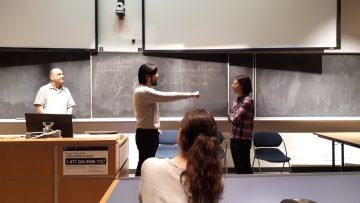 By Katharine Sedivy-Haley, Ph.D. Candidate, Hancock Lab
By Katharine Sedivy-Haley, Ph.D. Candidate, Hancock Lab
“You’re a room full of biologists – who can define homeostasis for me?”
Professor Tom Scholte of Conflict Theatre opened his workshop entitled “Difficult Conversations: A Missed Understanding” with this question. Humans, he explained, react consciously or unconsciously to maintain physical and psychological variables within comfortable parameters. When it’s cold, we might shiver or put on a sweater. When someone irritates us, we might avoid them or ask them to stop. Conflict, said Professor Scholte, occurs when two or more interacting systems attempt to set the same variable to different values. This is described in “Perceptual Control Theory.” Professor Scholte warned us that it can be difficult to tell what variable a system is trying to influence based solely on observed behaviour. His workshop provided Centre for Blood Research (CBR) and Microbiology & Immunology (M&I) Department members with a unique opportunity to learn about conflict dynamics through a theatrical exercise.
To identify situations relevant to CBR and M&I Department members, Professor Scholte asked for audience input. He had five workshop attendees act out a scenario with both internal and external conflict. In our scenario the “protagonist” was a graduate student who received a lower position in the authors list than was expected. The student desired important career-building recognition but was afraid of getting a reputation for being difficult to work with. I played the “antagonist”, the lead author who didn’t want to give the student the desired authorship. Other audience members took the “shapes” of three of the protagonist’s desires: questioning raised arms, an angry outstretched fist, and an anxious head cupped in one hand. We then acted out three different conversations. As the antagonist, I justified my decision, pushed back against the student’s accusations, and attempted to reassure the student that there was still time to build a publication record. At the end of each conversation, Prof. Scholte prompted us to reveal our inner thoughts: “I need this for my scholarship applications,” or “The other authors will be angry if I give you second author.”

Professor Scholte suggested that audience members could gain a better understanding of the systems driving a conflict by using the DEAR approach. Describe what’s happening, keeping to the observable facts. Explain the impact of the situation on you. Ask how other person feels – exercise empathy and try to understand that person’s perspective. Request something from the other person. Professor Scholte noted that sometimes the “Request” may change, based on what the other person says during the “Ask” step. He described a situation in which he thought a co-worker was ignoring him, but it turned out that the co-worker was shy. In this case, the “Request” became, “let’s have a beer and get to know each other!”
I attended this workshop, “Difficult Conversations: A Missed Understanding”, because of my interest in conflict dynamics. Difficult conversations often involve a number of different feelings and goals. Some of these may result in escalating conflict or damaged relationships, while others may encourage us to avoid conflict or appease others. How do these systems interact as we seek the homeostatic equilibrium between standing up for our needs and preserving relationships that are important to our academic success? And how might these conversations differ if we shared the things that we often don’t – like fears that we aren’t good enough or don’t belong?
There is only so much that can be done in a 90-minute workshop. However, the experience introduced me to a novel approach to understanding conflict. I found it very useful to isolate three different desires in the acting exercise, to examine how they might each contribute to the complex system that is a difficult conversation. In the future, I hope to see more workshops facilitated by Professor Scholte and more collaborations between the CBR and the M&I Department.


